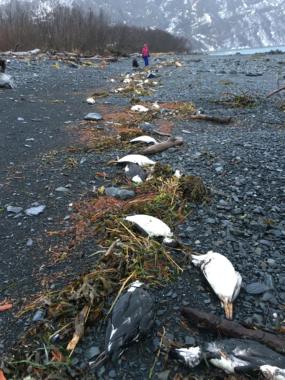
Alaskans may remember a few years ago, when huge numbers of common murres, a type of northern seabird, were washing up dead onshore. A new study from the University of Washington links the large die-off up to food scarcity during a period of extremely warm water temperatures.
In the fall of 2015, U.S. Fish & Wildlife Service biologist Robin Corcoran remembers over 100 murre carcasses lying beached in Kodiak’s Pasagshak Bay.
“Late August, early September was when we started to see a large number of birds dead on the beach and also birds just coming out of the water.” Corcoran said. “They were weak. Their plumage was pretty shabby. They were no longer waterproof. They were just starving to death.”
And that’s because with warming ocean temperatures, murres were losing their food source.
When the last “Blob” hit the Pacific, an area of the ocean larger than Canada experienced surface ocean temperatures rise as much as 7 degrees, completely altering the marine ecosystem for more than two years. The result was havoc in the food chain.
“It didn’t extinct anything but it just changed the rules of who was a winner and who was a loser,” said Julia Parrish, a professor of marine sciences at the University of Washington.
She said the ecosystem shift started with phytoplankton. Nutrient-rich cold-water phytoplankton began dying off, replaced by new, warm-water phytoplankton.
“The new species were smaller and not as energy dense. So less like a Clif bar, more like a rice cake. And all of that meant that the predators had to eat more to get enough to eat.”
Without a reliable source of phytoplankton, forage fish started to dwindle. And with fewer forage fish to eat, murres began to starve. In the span of about a year, Parrish estimates one million birds died from California to Alaska.
“I would say a million is a round number. I would also say it’s probably a conservative one,” she said. “It’s highly likely that more than a million birds died.”

near Whitter, Alaska, translating into about 8,000 bodies per mile of shoreline — one of the highest beaching rates recorded during the mass mortality event. (Photo courtesy of David B. Irons)
For climate scientists, murres are an excellent indicator of how some other marine species, like cod, are doing. And that’s simply because murres and cod eat the same forage fish. It’s no surprise then that Pacific cod have also experienced a sharp decline in the same Blob-affected areas that murres did.
NOAA fisheries biologist Steve Barbeaux has studied the cod crash for years. With another marine heat wave looming, he says murres are something to watch for this winter.
“If we see — like we did during the first heat wave — huge die off in murres, that would not be good for the cod population,” he said. “If the murres are starving to death, that means there’s not enough forage out there. And unfortunately, with the cod metabolism being so high, they could quickly end up in the same boat that we were at during the last heat wave.”
As far as recovery goes, Parrish says the outlook for murres is murky.
“I think that the warming ocean poses an uncertain future for murres,” she said. “I don’t believe that they are going to go extinct. But I believe the size of the populations that the marine environment can support will be lower.”
Parrish and Corcoran are among the authors of the new murre die-off study, released in the journal PLOS ONE on Jan. 15, 2020.